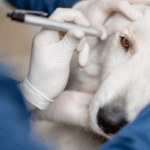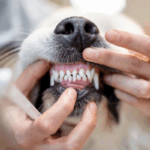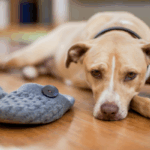With bottom scooting right up there on the list of “Unpleasant pet activities”, it’s no wonder that dogs are presented to us fairly frequently for this issue!
Scooting is your pet’s way of scratching an itch around their bottom, although female dogs may also scoot due to irritation around their vulva. Here we’ll go through some of the more common reasons for dogs to drag their bottoms along the ground, and how we can help get to the bottom of your pet’s discomfort.
What are the most common causes of bottom scooting in dogs?
The most common causes of bottom irritation in dogs are:
- Intestinal worms
- Anal sac impaction (blockages)
- Allergies
- Diarrhoea
How can we determine what is causing a pet’s bottom discomfort?
Determining the cause of a pet’s back-end discomfort can sometimes be done through a thorough history collection and physical examination alone, although some pets will require further diagnostic testing too.
At the start of the consultation, we will make enquiries about your pet’s deworming history (the products used and the frequency at which you administer them). If we are unsure about the effectiveness of your pet’s worming prevention routines, we may perform a worm egg check on their poo.
We will also ask about any other allergy-type symptoms that your pet may be demonstrating (such as frequent paw licking, ear infections, or rubbing at their face), and what the consistency of their stools is like.
Next, we will perform a full physical examination, with a particular focus on assessing your pet’s skin and ear health and checking their bottom. To check your pet’s anal sacs, we will need to gently insert a gloved, lubricated finger into their bottom. Most pets will tolerate this unless they are very sore or anxious, in which case sedation is recommended.
What treatment will my pet require?
Once we determine the likely cause for your pet’s bottom irritation, we can then suggest the appropriate treatment!
Anal sac blockages can often be treated with simple manual expression of a dog’s anal sacs, provided the pet will tolerate the process. However, if a pet’s anal sacs are badly blocked or infected, they may require sedation for a flush-out, followed by the application of an antibacterial/anti-inflammatory ointment into the sacs. Some dogs may require regular anal sac expression every 2-3 months and a high-fibre diet for long-term maintenance. However, if this doesn’t prevent the recurrence of infections, we may ultimately recommend surgical removal of your pet’s anal sacs.
Pets with intestinal worms will require an effective deworming treatment – this may be a combination product or, if zipper worm (a particularly hardy tapeworm) is suspected, a high dose of praziquantel.
If your pet is showing symptoms of recurrent skin or ear issues that suggest allergies, or recurrent diarrhoea that indicates an underlying gut issue, our vets will make suggestions for how we can further investigate their issue. This may involve:
- A prescription hypoallergenic dietary trial.
- Skin testing, such as checking skin samples obtained from your pet under the microscope for evidence of bacterial or yeast overgrowth or mites.
- Referral for specialist allergy testing.
- Imaging such as abdominal x-rays or ultrasound.
- Blood tests.
For more help keeping your pet feeling comfortable “back there”, consult our itch-informed team!






